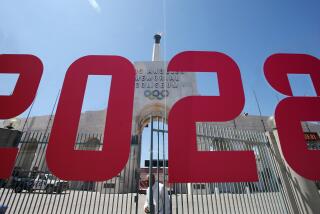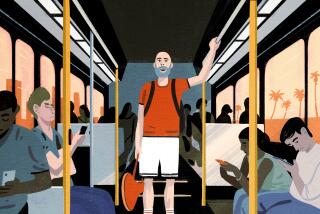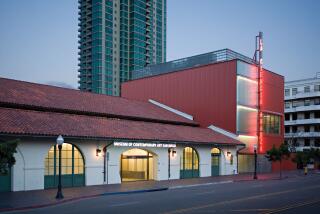Costly Enough to Stop a Bus in Its Tracks
- Share via
ANCHORAGE — Tom Wilson is faced with a problem that many city administrators would envy: How to spend $1.5 million on a bus stop?
When done, the bus stop next to the Anchorage Museum of History and Art will be like no other in the city, said Anchorage’s director of public transportation.
“It is going to be a showpiece stop,” Wilson said.
Wilson has $1.5 million to spend on the bus stop thanks to Alaska Sen. Ted Stevens -- commonly referred to by Alaskans as “Uncle Ted” for the Republican’s ability to secure federal money for his home state.
The money for the bus stop was contained in funding for intermodal transportation facilities in the $388-billion government spending bill passed by Congress in November. Stevens was the head of the Senate Appropriations Committee at the time.
Citizens Against Government Waste has ranked Stevens No. 1 every year since it began calculating “pork per capita” in 2000. In 2005, Stevens brought home more than $645 million, or $984.85 for each Alaskan, the group says.
Wilson acknowledges that the bus stop money has put him in an awkward position.
“I am walking a tightrope,” he said. “We have a senator that gave us that money, and I certainly don’t want to appear ungrateful.”
At the same time, Wilson said, he doesn’t want the public to think the city is going to waste the money.
“If it takes us only $500,000 to do it, that’s what we will spend,” he said.
The bus stop that now sits near the museum is a simple steel and glass, three-sided enclosure.
Wilson knows that he wants something more attractive and user-friendly, with better lighting and seating. He also likes the idea of heated sidewalks that would remain free of snow and ice. And he thinks that electronic signs would be nice.
One thing is certain. City and museum officials agree that the bus stop must fit in with the $75-million, grant-funded museum expansion project, which is to be completed in 2009.
“We want it to be complementary,” Wilson said. “We will try to do a signature piece that will stand well with the museum and show what we can do.”
Museum officials like the sound of that.
“We would like the bus stop to aesthetically fit in,” said museum director Pat Wolf. “We would like to help design it.”
In fact, architect Jon Kumin and landscape architect Charles Anderson have offered to help design the bus stop so that it fits with the new museum building.
“If the bus people don’t call us, we’re going to call them,” Wolf said. “We’d like to help them spend $1.5 million.”
While Wilson isn’t sure how to spend $1.5 million on one bus stop, the museum folks don’t see a problem.
“They shouldn’t worry. There are good uses for the money,” Kumin said. “This is going to be a great bus stop.”
He envisions a stop that is compatible with the exterior building materials used for the expansion -- translucent glass with a pattern to provide visual interest.
“It is a bit like looking through a thin curtain,” Kumin said of the look of the new museum building. “What we are looking for is depth.”
It’s important that the bus stop fit in with the view people will have while standing in what will be a mini-forest of 350 birch trees on the vacant lot at the new entrance to the museum, Anderson said.
The trees won’t have branches from about 8 feet down to allow museum visitors to look through the trees and onto the busy city street.
It’s important that the bus stop not block the view, the landscape architect said.
“It is an integrated design,” he said.
“It is important it not be a visual block and, like the birches, soften the view.”
Widening the sidewalks near the bus stop and creating a rounded intersection corner also would help ease congestion, Wolf said.
If done right, Wolf said, the expanded museum and improved bus stop could anchor a new eastern edge to the downtown, drawing not only more tourists to the museum, but shoppers from a nearby mall and workers from the federal building.
That’s what Stevens had in mind when he got the $1.5 million, said the senator’s spokeswoman, Courtney Boone.
“It is supposed to be a lot more than a bus stop,” she said. “It needs to have a way to smoothly transition all these people. That is why the money is earmarked.... We know from past experience what it takes.”
Wilson said he oversees the city’s ongoing bus stop enhancement program.
Enhancements typically cost from $10,000 to $100,000. What he has in mind for his bus stop might cost $500,000. The mayor said he might try to use the money on one or two other museum stops too.
Waiting for the No. 13 bus, Ronnie San Ramon of Anchorage mulled what he would do with $1.5 million.
With winter still a fresh memory, the answer wasn’t hard. He would make the bus stop fully enclosed and heated.
“People in winter are frozen -- especially if the bus is late, like today,” San Ramon said.
Another bus rider who didn’t want to give his name summed up his feelings about spending $1.5 million on the stop this way: “That is ridiculous.”
More to Read
Sign up for Essential California
The most important California stories and recommendations in your inbox every morning.
You may occasionally receive promotional content from the Los Angeles Times.










